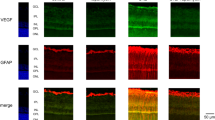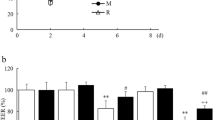Abstract
We have demonstrated that the expressions of small molecular weight G-protein, H-Ras, and its effector protein, Raf-1, are increased in the retina in diabetes, and the specific inhibitors of Ras function inhibit glucose-induced apoptosis of retinal capillary cells. This study is to examine the contributory roles for H-Ras in glucose-induced apoptosis of retinal endothelial cells by genetic manipulation of functionally active H-Ras levels. Bovine retinal endothelial cells were transfected with the plasmids of either wild type (WT), constitutively active (V12) or dominant-negative (N17) H-Ras. Glucose-induced increase in apoptosis, nitric oxide (NO) levels and activation of NF-κB and caspase-3 were determined in these genetically manipulated cells. Exposure of bovine retinal endothelial cells to 20 mM glucose significantly increased H-Ras activation as determined by Raf-1 binding assay. Overexpression of V12 in the endothelial cells further increased their glucose-induced apoptosis by 40%, NO levels by about 50%, and activated NF-κB and caspase-3 by about 30–40% compared to the untransfected cells incubated in 20 mM glucose. In contrast, overexpression of the inactive mutant, N17, inhibited glucose-mediated increases in apoptotic cell death, NO levels and NF-κB and caspase-3 activation; the values were significantly different (p < 0.02) compared to those obtained from the untransfected cells incubated under similar conditions. Our findings demonstrate that H-Ras activation is important in the activation of the specific signaling events leading to the accelerated retinal capillary cell apoptosis in hyperglycemic conditions, suggesting the possible use of H-Ras inhibitors to inhibit the pathogenesis of diabetic retinopathy.
Similar content being viewed by others
References
Engerman RL, Finkelstein D, Aguirre G, Diddie K, Fox R, Frank R, Varma S (1982) Appropriate animal models for research on human diabetes mellitus and its complications: Ocular complications. Diabetes 31(Suppl. 1): 82–88
Baynes JW, Thrope SR (1999) Role of oxidative stress in diabetic complications: A new perspective on an old paradigm. Diabetes 48: 1–9
Kowluru RA, Atasi L, Ho YS (2006) Role of mitochondrial superoxide dismutase in the development of diabetic retinopathy. Invest Ophthalmol Vis Sci 47: 1594–1599
Xia P, Aiello LP, Ishil H, Jiang ZY, Park DJ, Robinson GS, Takagi H, Newsome WP, Jirousek MR, King GL (1996) Characterization of vascular endothelial growth factor’s effect on the activation of protein kinase C, its isoforms, and endothelial cell growth. J Clin Inves 98:2018–2026
Stitt AW (2003) The role of advanced glycation in the pathogenesis of diabetic retinopathy. Exp Mol Pathol 75: 95–108
Mizutani M, Kern TS, Lorenzi M (1996) Accelerated death of retinal microvascular cells in human and experimental diabetic retinopathy. J Clin Invest 97: 2883–2890
Mizutani M, Gerhardinger C, Lorenzi M (1998) Muller cell changes in human diabetic retinopathy. Diabetes 47: 455–459
Barber AJ, Lieth E, Khin SA, Antonetti DA, Buchanan AG, Gardner TW (1998) Neural apoptosis in the retina during experimental and human diabetes. Early onset and effect of insulin. J Clin Invest 102: 783–791
Kern TS, Tang J, Mizutani M, Kowluru R, Nagraj R, Lorenzi M (2000) Response of capillary cell death to aminoguanidine predicts the development of retinopathy: Comparison of diabetes and galactosemia. Invest Ophthalmol Vis Sci 41: 3972–3978
Kowluru RA, Odenbach S (2004) Role of interleukin-1beta in the development of retinopathy in rats: Effect of antioxidants. Inves Ophthal Vis Sci 45: 4161–4166
Raff MC, Barres BA, Burne JF, Coles HS, Ishizaki Y, Jacobson MD (1993) Programmed cell death and the control of cell survival: Lessons from the nervous system. Science 262: 695–700
Esteban LM, Vicario-Abejon C, Fernandez-Salguero P, Fernandez-Medarde A, Swaminathan N, Yienger K, Lopez E, Malumbres M, McKay R, Ward JM, Pellicer A, Santos E (2001) Targeted genomic disruption of H-ras and N-ras, individually or in combination, reveals the dispensability of both loci for mouse growth and development. Mol Cell Biol 21: 1444–1452
Gulbins E, Coggeshall KM, Brenner B, Schlottmann K, Linderkamp O, Lang F (1996) Fas-induced apoptosis is mediated by activation of a Ras and Rac protein-regulated signaling pathway. J Biol Chem 271:26389–26394
Hendry BM, Khwaja A, Qu QY, Shankland SJ (2006) Distinct functions for Ras GTPases in the control of proliferation and apoptosis in mouse and human mesangial cells. Kidney Int 69: 99–104
Kowluru RA, Kowluru A, Chakrabarti S, Khan Z (2004) Potential contributory role of H-Ras, a small G-protein, in the development of retinopathy in diabetic rats. Diabetes 53: 775–783
Yu K, Chen YN, Ravera CP, Bayona W, Nalin CM, Mallon R (1997) Ras-dependent apoptosis correlates with persistent activation of stress-activated protein kinases and induction of isoform(s) of Bcl-x. Cell Death Differ 4: 745–755
Kowluru RA, Koppolu P (2002) Diabetes-induced activation of Caspase-3 in retina: Effect of antioxidant therapy. Free Radic Res 36: 993–999
Kowluru RA, Koppolu P, Chakrabarti S, Chen S (2003) Diabetes-induced activation of nuclear transcriptional factor in the retina, and its inhibition by antioxidants. Free Radic Res 7: 1169–1180
Kowluru RA, Odenbach S (2004) Effect of long-term administration of alpha lipoic acid on retinal capillary cell death and the development of retinopathy in diabetic rats. Diabetes 53: 3233–3238
Kowluru RA, Atasi L, Ho YS (2006) Role of mitochondrial superoxide dismutase in the development of diabetic retinopathy. Invest Ophthalmol Vis Sci 47: 1594–1599
Aktan F (2004) iNOS-mediated nitric oxide production and its regulation. Life Sci 75: 639–653
Meadows KN, Bryant P, Vincent PA, Pumiglia KM (2004) Activated Ras induces a proangiogenic phenotype in primary endothelial cells. Oncogene 23: 192–200
Aiello LP, Wong JS (2000) Role of vascular endothelial growth factor in diabetic vascular complications. Kidney Int 77: S113–S119
Tanaka Y, Nakayamada S, Fujimoto H, Okada Y, Umehara H, Kataoka T, Minami Y (2002) H-Ras/mitogen-activated protein kinase pathway inhibits integrin-mediated adhesion and induces apoptosis in osteoblasts. J Biol Chem 277: 21446–21452
Cox AD, Der CJ (2003) The dark side of Ras: Regulation of apoptosis. Oncogene 22: 8999–9006
Tseng YS, Tzeng CC, Chiu AW, Lin CH, Won SJ, Wu IC, Liu HS (2003) Ha-ras overexpression mediated cell apoptosis in the presence of 5-fluorouracil. Exp Cell Res 288: 403–414
Rahman I, MacNee W (2000) Regulation of redox glutathione levels and genestranscription in lung inflammation: Therpeutic approaches. Free Radic Biol Med 28: 1405–1420
Valen G (2003) Signal transduction through nuclear factor kappa B in ischemia-reperfusion and heart failure. Basic Res Cardiol 99: 1–7
Romeo G, Liu WH, Asnaghi V, Kern TS, Lorenzi M (2002) Activation of nuclear factor-kappaB induced by diabetes and high glucose regulates a proapoptotic program in retinal pericytes. Diabetes 51: 2241–2248
Joussen AM, Huang S, Poulaki V, Camphausen K, Beecken WD, Kirchhof B, Adamis AP (2001) In vivo retinal gene expression in early diabetes. Invest Ophthalmol Vis Sci 42: 3047–3057
Hanson JL, Anest V, Reuther-Madrid J, Baldwin AS (2003) Oncoprotein suppression of tumor necrosis factor-induced NF kappa B activation is independent of Raf-controlled pathways. J Biol Chem 278: 34910–34917
Bernabe JC, Tejedo JR, Rincon P, Cahuana GM, Ramirez R, Sobrino F, Bedoya FJ (2001) Sodium nitroprusside-induced mitochondrial apoptotic events in insulin-secreting RINm5F cells are associated with MAP kinases activation. Exp Cell Res 269: 222–229
Ho FM, Liu SH, Liau CS, Huang PJ, Lin-Shiau SY (2000) High glucose-induced apoptosis in human endothelial cells is mediated by sequential activations of c-Jun NH(2)-terminal kinase and caspase-3. Circulation 101: 2618–2624
Song P, Wei J, Plummer H, Wang HC (2004) Potentiated caspase-3 in Ras-transformed 10T1/2 cells. Biochem Biophys Res Commun 322: 557–564
Kowluru RA (2001) Diabetes-induced elevations in retinal oxidative stress, protein kinase C and nitric oxide are inter-related. Acta Diabetol 38: 179–185
Acknowledgment
Technical assistance of Shivapriya Basak is greatly appreciated. This study was supported in part by grants from the National Institutes of Health, Juvenile Diabetes Research Foundation, Thomas Foundation, and Research to Prevent Blindness.
Author information
Authors and Affiliations
Corresponding author
Rights and permissions
About this article
Cite this article
Kowluru, R.A., Kowluru, A. & Kanwar, M. Small molecular weight G-protein, H-Ras, and retinal endothelial cell apoptosis in diabetes. Mol Cell Biochem 296, 69–76 (2007). https://doi.org/10.1007/s11010-006-9299-z
Received:
Accepted:
Published:
Issue Date:
DOI: https://doi.org/10.1007/s11010-006-9299-z




